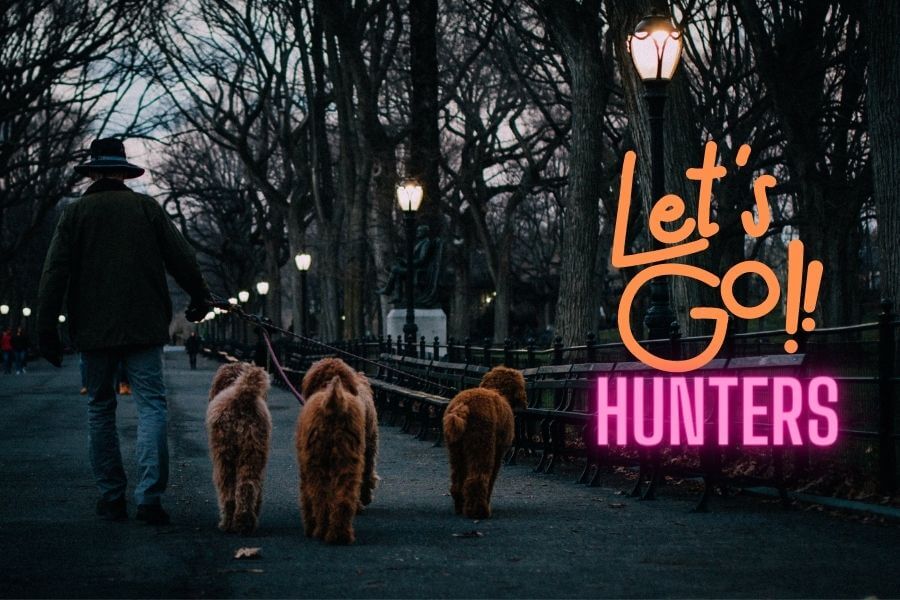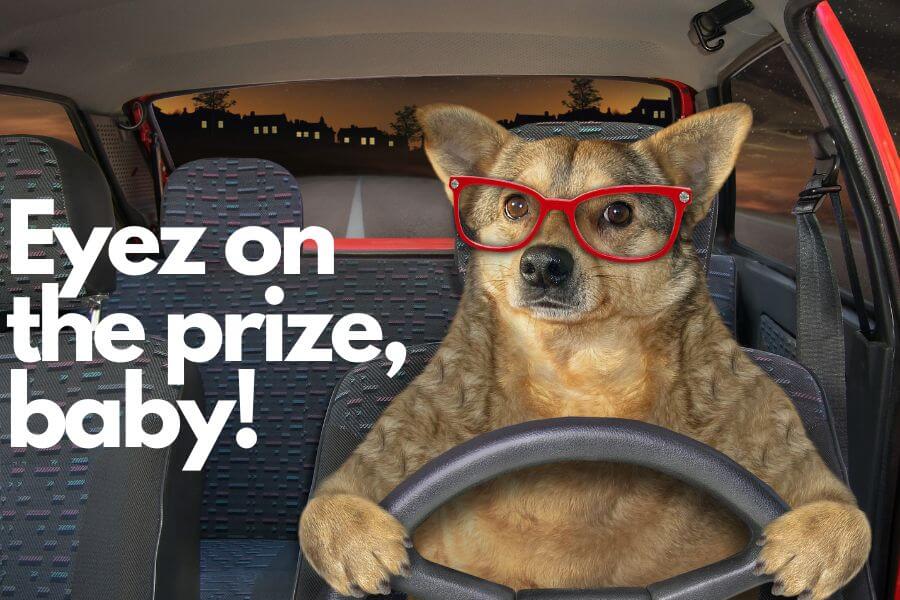Key Takeaways
- Dogs see in the dark!
- Dogs have night vision thanks to a structure in their eye called the tapetum lucidum, which allows them to reflect light off the back of their retina.
- Dogs have higher levels of rods than humans and more melatonin in their eyes, allowing them to see better at night.
- Humans are not as good at seeing in dim light and darkness as dogs because they do not have this structure in their eyes.
- A dog’s vision may worsen with age due to rigid lenses that become less flexible over time, leading them to be more prone to developing certain diseases like cataracts or entropion – eyelids turning inward, irritating the eyeball.
Do Dogs Have Night Vision? Dog’s Eye Anatomy

Do dogs have night vision? The answer to this question is yes, dogs can see at night. Dogs are able to see in low light and even darkness because they have a structure in their eye called the tapetum lucidum. This structure allows dogs to reflect light off the back of their retina, which increases the amount of light that is available to them. This is why dogs are often seen as having „cat-like” pupils because cats also have a tapetum lucidum in their eye.
Dogs are not the only animals that have tapetum lucidum in their eye. It is also found in the eyes of cats, raccoons, bears, and wolves. This structure allows these animals to see in dim light and even darkness, which gives them an edge when hunting or scavenging for food.
It is interesting to note that humans do not have this structure in their eye. This is because humans evolved from a species of ape that did not have this structure. This is one of the reasons why humans are not as good at seeing in dim light and darkness as dogs are.
Dog Eyes Vs. Human Eyes. Do Dogs See Color?
The eyes of a human and a dog are very different. Dogs have a higher number of rods than humans, which means they can see in poor light conditions better than we can. As we said before, dogs also have a layer of reflective cells called the tapetum lucidum that helps them see better in the dark. Dogs also have a higher level of melatonin in their eyes than humans. This hormone is responsible for regulating the body’s internal clock, and it also helps to improve night vision.
Humans have a higher concentration of cone cells in their eyes, which allows them to see colors and details in brighter light. However, cone cells are not as sensitive to low light conditions as rod cells, so humans tend to lose their ability to see detail in the dark over time.
Dogs also have a wider field of vision, meaning they can see more of their surroundings at one time. This comes in handy when they are tracking prey or trying to find their way home. Overall, human and dog vision are both very different and each has its own advantages.
All of these differences allow dogs to see in much better detail than humans in low light conditions. This makes them better able to navigate their environment and find prey, especially at night. So next time you’re out for a walk late at night, be sure to bring your furry friend along – they’ll be able to see much better than you! Read our article on Do Dogs See Color and stay in the loop!
After All, Canine Eyesight Is Not Perfect

Vision is an important sense for dogs, and all dog owners should make sure that they get the care they need to maintain healthy vision. By taking your dog to the vet for regular checkups, you can help ensure that their vision stays healthy, and they can continue to enjoy all the activities that they love. Most dogs have normal vision, but there are some breeds of dogs that are more prone to specific eye conditions.
For example, Bulldogs are prone to cherry eye, a condition in which the gland that lubricates the eyeball pops out of its normal position. In most cases, cherry eye can be treated with surgery. Cocker Spaniels are prone to Progressive Retinal Atrophy (PRA), a condition that leads to blindness. There is no known cure for PRA, but dogs with the condition can lead normal lives if they are fitted with special glasses or contact lenses.
Some other dog breeds that are prone to specific eye conditions include the German Shorthaired Pointer, which is prone to cataracts. The Rottweiler is prone to entropion, a condition in which the eyelashes grow inward and irritate the eyeball. So not all breeds of dogs have the same visual conditions, and this is something that you should be aware of if you are considering getting a dog.
Dog Vision Can Deteriorate with Age
A dog’s vision may worsen as he or she gets older. This is because the lenses of a dog’s eyes may become more rigid and less flexible with age, which can lead to problems with seeing clearly. Additionally, the retina (the part of the eye that senses light) may also deteriorate with age, which can affect a dog’s ability to see clearly.
As a result, older dogs may have a harder time seeing in low light or dark environments, and they may also be more prone to developing eye diseases. If you notice that your dog is having trouble seeing clearly, be sure to take him or her to the veterinarian for a check-up.
Editor’s Note
My friend’s dog, Toto, is one of the most alert and observant animals I know. Recently, she noticed some rustling in the bushes near our house late one night. After a few moments of investigation, Toto realized it was just a small family of raccoons.
This experience reminded us that animals can often sense danger before humans do. If you ever find yourself in a similar situation, it’s always best to stay calm and listen to your pet’s intuition, and know that their night vision is amazing. They may just save you from a potentially dangerous situation!
Some Interesting Facts About Dog’s Eyesight

- Dogs have a wider field of vision than people, allowing them to see more of their surroundings at one time.
- Dogs have a third eyelid that helps keep their eyes lubricated and healthy. This eyelid is usually only visible when the dog’s eyes are open very wide.
- Dogs also have a higher concentration of cones, which are responsible for color vision. This allows dogs to see a wider range of colors than most other animals.
- Dogs can see movement much better than humans can. This is why many dogs are used as Seeing Eye dogs.
- Dogs rely heavily on their vision to navigate their surroundings and to interact with the people and animals around them. This is why it’s important to keep your dog’s eyes healthy and clear by taking him or her to the veterinarian for regular checkups.
Do dogs have night vision? Definitely yes, and that’s why they are more likely to be active at night when most humans are asleep.
Frequently Asked Questions
What Color Do Dogs See in the Dark?
Humans often take for granted the amazing range of colors they get to experience. But, dogs have a distinct advantage over us; with their limited color perception being restricted only to shades of yellow, blue, and violet – life must look pretty dreamy through canine eyes!
Can Dogs See in Total Darkness?
They can see in the dark, but not in TOTAL darkness.
Can Dogs See in the Mirror?
Self-awareness in animals? Tests have been performed, and curiously, dogs have appeared to flunk this seemingly simple test or did they? Recent findings are prompting scientists and dog owners alike to reevaluate if the classic version of this assessment is an accurate gauge for understanding a pup’s sense of identity.
Should You Look a Dog in the Eyes?
It’s not recommended for a stranger to look a dog directly in the eyes as this can be seen as a challenge or threat and can cause them to react defensively.
How Do Dogs See Human Faces?
Contrary to popular belief, our furry friends may not be as in tune with us when it comes to reading facial cues. A study conducted by the Eötvös Loránd University of Hungary has uncovered evidence that dogs’ brains don’t differentiate between a person’s face and their back-of-head, seemingly oblivious to human expression. While faces are fundamental for humans interacting visually, they evidently aren’t quite so important for man’s best friend!
Lucas Taylor is a veterinary assistant, freelance journalist and single dad who lives in the suburbs with his three pups: Ruby, Nala, and Woody. He has one cat named Pepper. When he’s not writing articles or working at the vet clinic, Lucas loves cooking French cuisine for himself and friends at home. One of Lucas’ favorite things to do is paddleboard with his son Noah and their canine companions. Pepper is the homebody of the bunch – she loves chilling on the couch.











